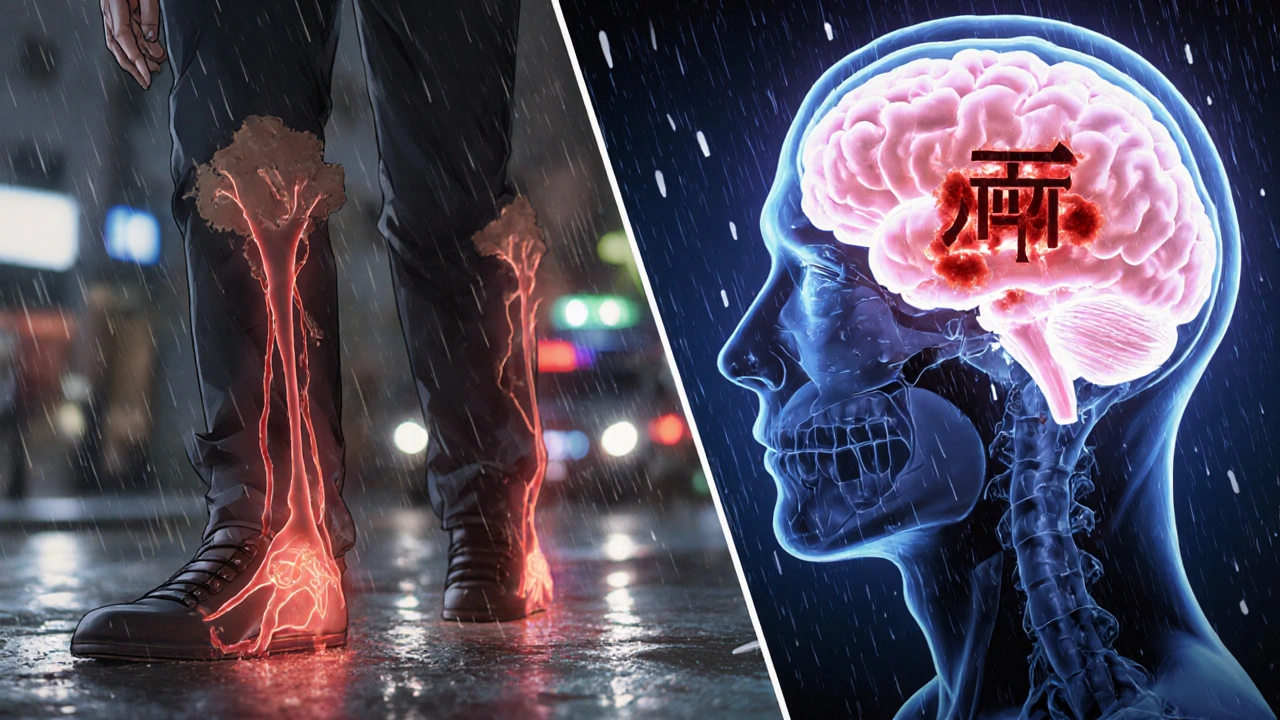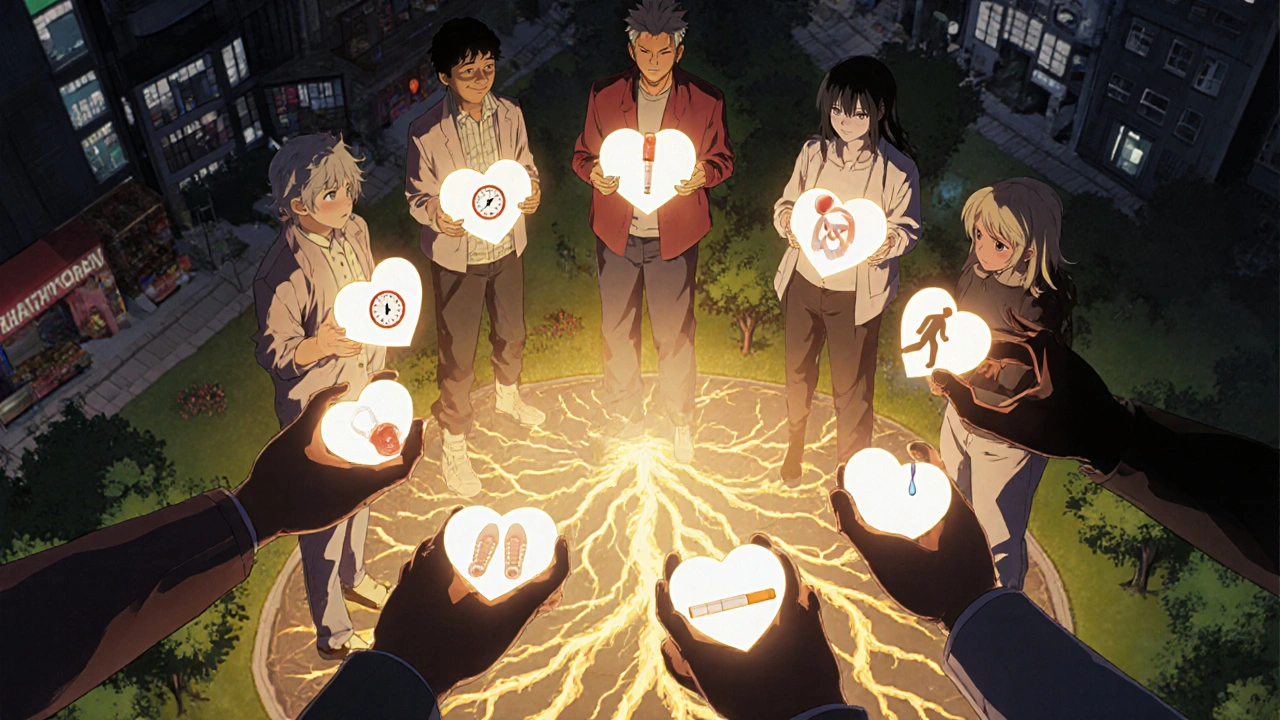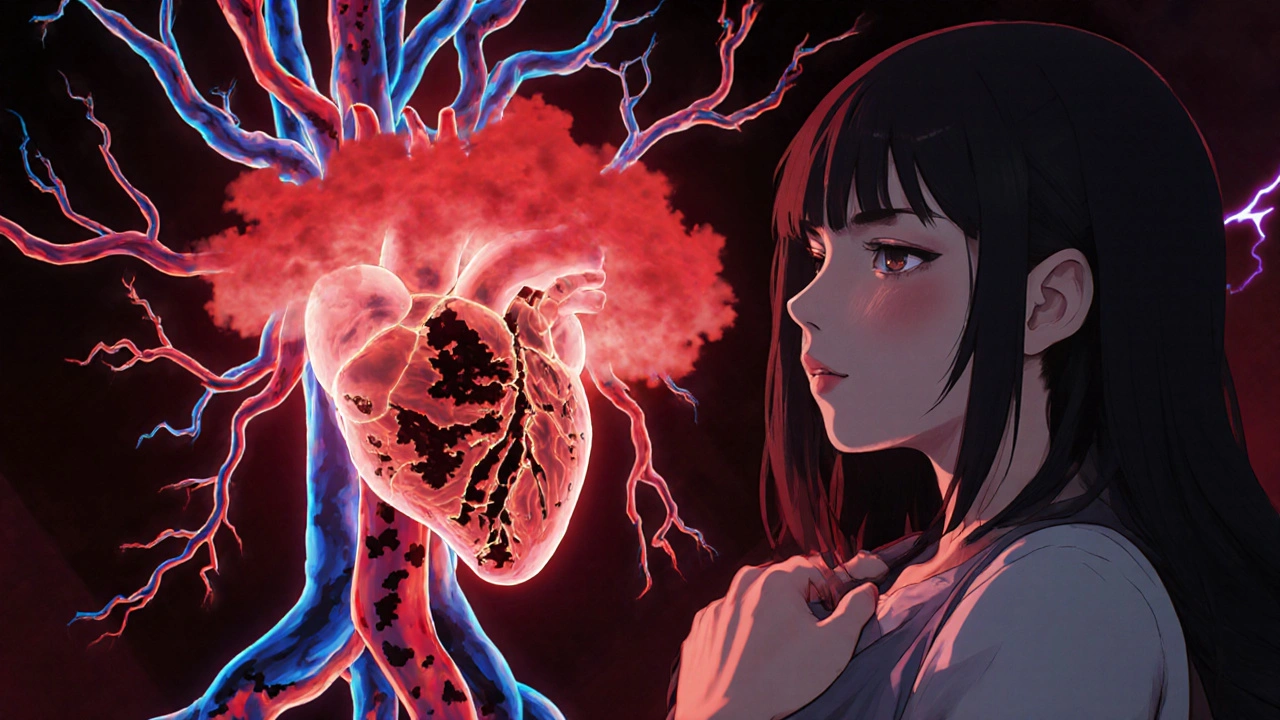More than 800,000 people in the U.S. die each year from cardiovascular disease. That’s nearly one-third of all deaths. It’s not just older adults either-heart attacks and strokes are rising in people in their 30s and 40s. The truth is, cardiovascular disease isn’t one thing. It’s a group of conditions that all start with the same problem: your heart and blood vessels aren’t working right. And if you don’t know the difference between a heart attack, a stroke, and blocked arteries in your legs, you’re not alone.
What Exactly Is Cardiovascular Disease?
Cardiovascular disease, or CVD, is an umbrella term for anything that goes wrong with your heart or blood vessels. That includes coronary artery disease, heart failure, stroke, and peripheral artery disease. The most common cause? Atherosclerosis-when fatty deposits build up in your arteries and slowly clog them. This isn’t just about cholesterol. It’s inflammation, high blood pressure, diabetes, and even stress all teaming up to damage the inside of your blood vessels.
The American Diabetes Association calls this group of conditions atherosclerotic cardiovascular disease, or ASCVD. That’s the technical term for when you’ve had a heart attack, stroke, angioplasty, or even a blocked artery in your leg. If you’ve had any of those, you’re in the high-risk group. And here’s the scary part: if you have type 2 diabetes, your risk of having a heart attack is the same as someone who already had one.
Heart Disease: The Silent Killer
Coronary artery disease is the most common type of heart disease. It happens when plaque builds up in the arteries that feed your heart muscle. You might not feel anything until it’s too late. That’s why so many people have their first heart attack with no warning.
But symptoms aren’t always the classic chest pain you see in movies. For women, older adults, and people with diabetes, it’s more likely to be fatigue, nausea, jaw pain, or shortness of breath while walking up stairs. If you’ve been ignoring those signs because "it’s just aging," you’re putting yourself at risk.
Doctors now use something called coronary artery calcium scoring to catch this early. It’s a quick CT scan that shows how much calcium is stuck in your heart arteries. If your score is high-even if you feel fine-it means you need to act now. The 2023 ACC/AHA guidelines recommend this test for people with a 7.5% to 20% chance of a heart event in the next 10 years. That’s not just older people. It’s people with high blood pressure, high cholesterol, or a family history.
Stroke: When the Brain Goes Dark
Stroke is a cardiovascular event, even though it hits the brain. It happens when a blood vessel in the brain gets blocked or bursts. Every 40 seconds, someone in the U.S. has a stroke. And every four minutes, someone dies from one.
There are two main types: ischemic (clot) and hemorrhagic (bleed). Ischemic strokes make up 87% of cases. They’re often caused by the same plaque buildup that causes heart attacks. The difference? It’s not your heart muscle starving for oxygen-it’s your brain.
Know the signs using FAST:
- Face drooping
- Arm weakness
- Speech difficulty
- Time to call 911
Waiting even 15 minutes can mean the difference between full recovery and lifelong disability. The faster you get to the hospital, the more brain tissue you can save. And yes-stroke can happen to young people. The rate of stroke in adults under 55 has jumped 25% since 2000.

Vascular Conditions: More Than Just Legs
Peripheral artery disease, or PAD, affects about 6.5 million Americans over 40. It’s when arteries in your legs, arms, or stomach get blocked. You might think it’s just leg pain when you walk-but it’s your body screaming that your blood flow is cut off.
People with PAD have a much higher risk of heart attack and stroke. In fact, if you have PAD, your chance of dying from heart disease in the next 10 years is nearly 50%. And here’s something most don’t know: if you can’t feel your foot pulses or your toes are cold and blue, that’s a red flag.
Even worse, aortic aneurysms-when the main artery from your heart balloons out-can rupture without warning. Men over 65 who ever smoked should get a one-time ultrasound screening. It’s simple, painless, and can save your life.
The Real Risk Factors (It’s Not Just Cholesterol)
You’ve heard the list: high cholesterol, high blood pressure, smoking. But the real story is deeper.
- Hypertension: 116 million U.S. adults have it. Only half have it under control.
- Diabetes: 11.3% of adults have it. And if you have it, your heart disease risk doubles.
- Obesity: 41.9% of adults have a BMI over 30. Fat tissue isn’t just extra weight-it’s active inflammation.
- Smoking: Even one cigarette a day raises your heart attack risk by 50%.
- Depression: This one surprises people. If you’re depressed, your risk of heart disease goes up by 30%. And if you’ve had a heart attack, you’re three to four times more likely to become depressed.
These aren’t separate problems. They’re connected. That’s why experts now talk about "cardiometabolic syndrome"-a cluster of conditions that feed each other. High blood sugar makes your blood vessels sticky. High blood pressure tears them. Fat tissue pumps out chemicals that cause inflammation. And stress makes it all worse.
What Works: The New Science of Prevention
Medicine has changed. It’s not just about popping a statin and calling it a day. The Steno-2 trial showed that when you treat multiple risk factors at once-blood sugar, blood pressure, cholesterol, and lifestyle-you can cut heart events by more than half.
Today’s top guidelines (ADA, ACC/AHA, ESC) all agree on this:
- If you have diabetes and heart disease, you need an SGLT2 inhibitor or GLP-1 receptor agonist-not just metformin. These drugs protect your heart and kidneys, even if your blood sugar is fine.
- LDL cholesterol targets are getting stricter. For very high-risk patients, doctors now aim for under 55 mg/dL, not 70.
- Aspirin is no longer routine for everyone. Only use it if your doctor says so-it can cause dangerous bleeding.
- Depression screening is now part of heart care in Europe. The U.S. is catching up.
And it’s not all pills. The CDC’s HEARTS program has cut heart disease deaths by 15-25% in 21 countries by training clinics to manage blood pressure, offer healthy food options, and help people quit smoking. Johnson & Johnson reduced CVD risk by 26% in employees after 10 years of workplace wellness programs.

Why You Can’t Ignore This
Cardiovascular disease costs the U.S. $444 billion a year. By 2035, that will hit $1.1 trillion. But the real cost isn’t money-it’s lost time, lost independence, lost life.
And it’s not fair. Black Americans die from heart disease at 30% higher rates than White Americans-even when they have the same cholesterol, blood pressure, and access to care. Why? Because zip code matters more than genetics. Food deserts, lack of safe places to walk, chronic stress from discrimination-these are the hidden drivers.
Million Hearts™, a national initiative, aims to prevent a million heart attacks and strokes by 2027. Their ABCS strategy works: Aspirin when needed, Blood pressure control, Cholesterol management, Smoking cessation. States using it have already seen a 14% drop in CVD deaths.
What You Can Do Today
You don’t need a perfect diet or a gym membership. Start small:
- Get your blood pressure checked-every year, or more often if it’s high.
- Ask your doctor about your LDL cholesterol and if you need a calcium score.
- If you smoke, quit. Even cutting down helps, but quitting is the only thing that truly reverses damage.
- If you have diabetes or prediabetes, ask about SGLT2 or GLP-1 medications. They’re not just for sugar.
- Move for 30 minutes a day. Walk, dance, garden-it doesn’t matter. Just move.
- Check in on your mental health. If you’re feeling down, talk to someone. Depression is a heart risk factor.
Cardiovascular disease isn’t inevitable. It’s not just genetics or bad luck. It’s the result of systems-your body, your environment, your care-that have been ignored for too long. But you can change your path. Right now.
What’s the difference between a heart attack and a stroke?
A heart attack happens when blood flow to the heart muscle is blocked, usually by a clot in a coronary artery. A stroke happens when blood flow to the brain is interrupted-either by a clot (ischemic stroke) or a burst blood vessel (hemorrhagic stroke). Both are caused by atherosclerosis, but they affect different organs. One damages your heart; the other damages your brain.
Can you have cardiovascular disease without symptoms?
Yes. Many people with coronary artery disease or peripheral artery disease feel nothing until they have a heart attack, stroke, or severe leg pain. That’s why screening tests like blood pressure checks, cholesterol panels, and coronary calcium scoring are so important-even if you feel fine.
Are statins still the best treatment for high cholesterol?
Statins are still the first-line treatment for most people with high LDL cholesterol. But for those with diabetes, heart disease, or a history of heart attack, newer drugs like SGLT2 inhibitors and GLP-1 receptor agonists are now recommended alongside statins because they offer extra heart and kidney protection. Statins lower cholesterol; these drugs change how your body handles fat, sugar, and inflammation.
Is cardiovascular disease preventable?
Yes, up to 80% of cardiovascular disease is preventable through lifestyle and medical management. Controlling blood pressure, cholesterol, and blood sugar, quitting smoking, staying active, and managing stress can reduce your risk dramatically-even if you have a family history.
Why does depression increase heart disease risk?
Depression triggers chronic stress, which raises cortisol and inflammation. It also leads to poor sleep, less movement, unhealthy eating, and skipping medications. People with depression are less likely to follow treatment plans. Studies show treating depression alongside heart disease improves survival and adherence to meds by up to 22%.
Should I get screened for peripheral artery disease?
If you’re over 65, or over 50 and smoke or have diabetes, yes. The simplest test is an ankle-brachial index (ABI), which compares blood pressure in your ankle to your arm. If it’s low, you may have blocked leg arteries. PAD is a warning sign-your heart arteries are likely blocked too.
What’s Next?
If you’ve read this far, you’re already ahead of most. The next step isn’t a fancy supplement or a new diet trend. It’s a conversation-with your doctor, your family, or yourself.
Ask: Do I know my numbers? Am I taking my meds as prescribed? Do I have someone to talk to if I’m feeling overwhelmed? Are my daily choices helping or hurting my heart?
Cardiovascular disease doesn’t happen overnight. But neither does recovery. Every healthy meal, every walk, every time you say no to smoking or yes to sleep-it adds up. You don’t have to be perfect. You just have to start. And you’re not alone in this.



9 Comments
sharicka holloway November 28, 2025 AT 04:21
Cardiovascular disease isn’t just a medical issue-it’s a social one. I’ve seen friends in their 30s with diabetes and high blood pressure because they work two jobs and can’t afford healthy food. No one talks about how zip codes determine your heartbeat. This post nails it. We need policy changes, not just pills.
Alex Hess November 29, 2025 AT 14:51
Ugh. Another feel-good health article pretending lifestyle changes fix systemic failure. Statins don’t work for everyone, and yes, I’ve read the guidelines. But telling people to ‘just move more’ while they live in food deserts with no sidewalks is pure performative nonsense. This isn’t about willpower-it’s about power.
Leo Adi December 1, 2025 AT 12:27
In India, we see this too-young people with heart attacks, no smoking, no obesity, but constant stress from family pressure and long commutes. The real villain isn’t cholesterol-it’s silence. No one talks about mental strain. I lost my cousin at 34. He never said he was tired. He just stopped breathing one morning.
Melania Rubio Moreno December 1, 2025 AT 13:40
why do ppl keep sayin ‘quit smokin’ like its the only thing? i mean, i know its bad but what about all the sugar in the ‘healthy’ smoothies? i got a friend who drinks kale juice every day and still got a stroke. wtf.
Gaurav Sharma December 3, 2025 AT 06:25
There is a critical flaw in your analysis. The article conflates correlation with causation in the depression-cardiovascular link. The data is observational. No controlled trials prove depression causes heart disease. It may be a confounder. You are promoting pseudoscience.
Sam HardcastleJIV December 3, 2025 AT 18:15
While the statistical data presented is undeniably compelling, one must question the epistemological foundation of the recommendations. The reliance on population-based guidelines assumes homogeneity of biological response, which is demonstrably false. Individual variability in drug metabolism, epigenetic expression, and environmental exposure renders blanket protocols ethically dubious.
Mira Adam December 4, 2025 AT 06:37
Oh please. ‘Just move for 30 minutes’? That’s what you tell someone working night shifts, raising kids, and drowning in medical debt? This article is a luxury for people who have time and privilege. The real solution isn’t walking-it’s universal healthcare and paid sick leave. Stop blaming individuals for broken systems.
Miriam Lohrum December 5, 2025 AT 05:34
It’s interesting how we treat the body like a machine you can fix with parts. But the heart doesn’t just pump blood-it holds grief, fear, joy, trauma. Maybe the real prevention isn’t calcium scores or LDL targets, but learning how to sit with pain instead of medicating it away. We’ve outsourced healing to clinics and pills. What if we started listening instead?
archana das December 6, 2025 AT 02:02
My aunt in Delhi had diabetes and high BP. She didn’t take medicine because it cost too much. But she walked every morning in the park, cooked with turmeric and lentils, and talked to her neighbors. No doctor told her to do that. But she lived longer than anyone expected. Sometimes the simplest things are the strongest.